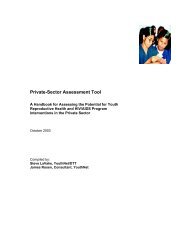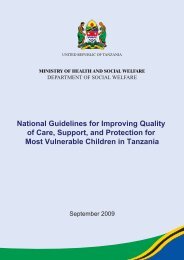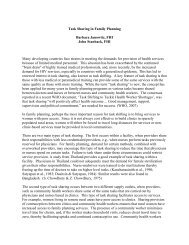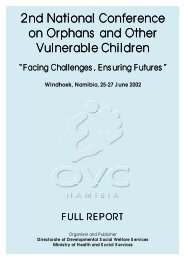Palliative Care Strategy for HIV and other diseases - FHI 360
Palliative Care Strategy for HIV and other diseases - FHI 360
Palliative Care Strategy for HIV and other diseases - FHI 360
Create successful ePaper yourself
Turn your PDF publications into a flip-book with our unique Google optimized e-Paper software.
6<br />
2. extent of palliative care need<br />
Although palliative care is an essential <strong>for</strong>m of care, it is frequently unavailable to those<br />
who need it. Every year, millions endure pain or psychosocial <strong>and</strong> spiritual suffering. Millions<br />
more struggle to care <strong>for</strong> sick loved ones or grieve their loss. And while a vast number<br />
of children need palliative care, the availability of pediatric palliative care programs is even<br />
more limited than <strong>for</strong> adults. 7<br />
An estimated 33.2 million people are living with <strong>HIV</strong> <strong>and</strong> an<strong>other</strong> 24 million with cancer,<br />
three-quarters of them in resource-limited countries. 8, 9 By 2025, more people will die from<br />
chronic illness rather than acute illness. 10 Over the next 50 years cancer rates in Africa are<br />
expected to grow by 400 percent. 11, 12 Study after study shows that people with such lifethreatening<br />
illness experience high rates of pain <strong>and</strong> psychosocial <strong>and</strong> spiritual distress<br />
throughout the trajectory of the illness. 13<br />
<strong>Palliative</strong> care needs are often under-assessed <strong>and</strong> under-addressed. Up to 80 percent of<br />
pain in PL<strong>HIV</strong> is under-treated. 14 And about two-thirds of palliative care needs are missed<br />
on clinical visits. 15 Some populations, such as women <strong>and</strong> drug users, are documented to<br />
have more palliative care needs than <strong>other</strong>s. 16 Both populations are more likely to have<br />
problems under-assessed, <strong>and</strong> have higher levels of physical <strong>and</strong> psychosocial suffering <strong>and</strong><br />
17, 18, 19<br />
lower quality of life.<br />
palliative <strong>Care</strong> needs oF plhiv<br />
Between 30 <strong>and</strong> 98 percent of people with <strong>HIV</strong> experience pain, which generally increases<br />
in frequency <strong>and</strong> severity toward the end of life. 20, 21 Among those with AIDS, the range is 63<br />
to 98 percent. Studies documenting pain among PL<strong>HIV</strong> on ART have found from 30 to 60<br />
percent presenting with moderate to severe pain. 22, 23, 24 Physical symptoms, including pain,<br />
are also experienced early in diagnosis <strong>and</strong> during ambulatory periods of disease. 25<br />
Prevalence of <strong>other</strong> symptoms is also high among people with <strong>HIV</strong>. Distressing symptoms<br />
can range from fatigue to nausea <strong>and</strong> insomnia. In people who are symptomatic or have<br />
AIDS, the following symptoms are particularly prevalent:<br />
•<br />
•<br />
•<br />
•<br />
•<br />
•<br />
anorexia (63 percent)<br />
fatigue (60–71 percent)<br />
fever (48 percent)<br />
insomnia (51–55 percent)<br />
skin problems (34–72 percent)<br />
26, 27, 28<br />
cough (37–58 percent)<br />
However, symptoms <strong>and</strong> medication-related side effects are also common among PL<strong>HIV</strong><br />
on ART. The presence of symptoms <strong>and</strong> side effects has also been documented as a barrier<br />
29, 30, 31<br />
to ART adherence in a growing number of studies.<br />
Psychological distress is also prevalent. PL<strong>HIV</strong> in the United States are three times more<br />
likely to have psychiatric illness than those who are <strong>HIV</strong>-negative. Studies show that from<br />
38 to 75 percent of PL<strong>HIV</strong> will experience one psychiatric disorder. 32 Rates of depression<br />
range from 22 to 63 percent (15 percent is the rate of depression in the general US popula-
















